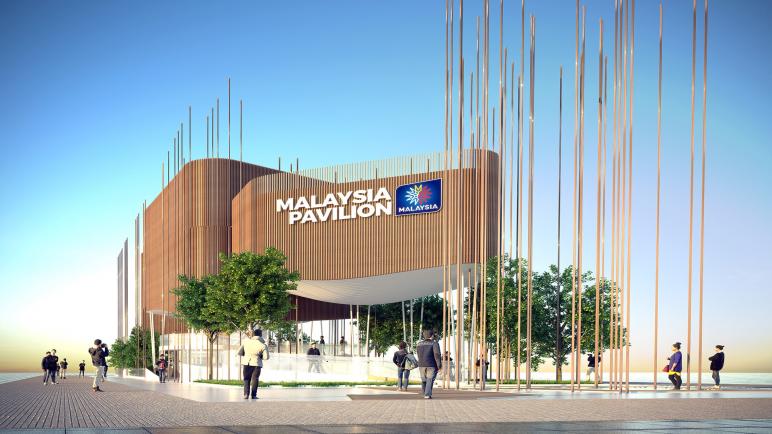Malaysia at EXPO 2020 DUBAI
• Net Zero Carbon pavilion on 1,234.05 sq. metres
• Concept an architectural marvel to provide visitors a sublime experience of Man-Nature symbiotic relationship
Dubai, United Arab Emirates, March 31, 2021: Malaysia today unveiled the details of the unique `Rainforest Canopy’ concept at its EXPO 2020 country pavilion, highlighting its commitment to sustainability.
Addressing a press conference, the Malaysian Ambassador to the UAE, H.E Mohd Tarid Sufian said, the pavilion spanning an area of 1,234.05 sq. metres, is the first Net Zero Carbon initiative at Expo 2020, and is an architectural marvel blending esoteric design with animation elements to provide a sublime experience of Man-Nature relationship to visitors.
“We wanted to remind the need to have a sustainable outlook on life and business in these challenging times through our `Rainforest Canopy’ concept at EXPO 2020, a nodal global event contributing to the efforts of a post-COVID economic recovery,” the Ambassador said.
For Malaysia, Expo 2020 is a strategic platform to accelerate economic growth and tide over the impact of the pandemic, and to communicate to the world its focus on sustainable solutions, he said, while congratulating the UAE for holding the event taking on the challenges seamlessly.
The Malaysian pavilion will have participation from 22 government ministries, 40 agencies and five state governments. Together the entities will conduct 26 weekly trade and business programmes throughout the show for six months. It is also estimated that at least 200 Malaysian business delegations will also be part of the large contingent of participants from the country.
“In line with the theme of EXPO 2020 – ‘Connecting Minds, Creating Future,’ – the Pavilion will bring together a diverse group of businesses from over 10 different industry verticals spread across six clusters,” H.E Mohd Tarid Sufian said.
Sustainability Focus
Malaysia’s commitment to sustainability and fostering symbiotic relationship between Man and Nature is the focus of the pavilion. The Theme of the pavilion is `Energising Sustainability,’ – which captures the country’s commitment to balance socio-economic progress with environmental protection.
Situated between the Sustainability District and Mobility District at the EXPO 2020 premises, the pavilion is a rare endeavor to highlight the benevolence of Nature’s harmony and the need for humanity to be sensitive to it. Meranti wood has been extensively used for the pavilion’s façade to make a statement of Malaysia’s sustainable forestry practices and timber products. To enhance the impact of the design a novel engineering method has been deployed to project the meranti outward.
“You will find the `Rainforest Canopy’ concept in the middle of the desert enchanting, complete with tree clusters to walk through flanked by robust flora and fauna and a river meandering in between. The aim is to rekindle the experience of the benign Nature and reflect on how it has protected mankind all along,” said Mr. Shamsul Bahar Mohd. Nor, CEO of the Malaysian Green Technology and Climate Change Centre (MGTC), the implementing agency for Malaysia’s participation in Expo 2020.
The lead ministry for Malaysia’s overall participation is the Ministry of Science, Technology and Innovation.
He said the message of sustainable living and environmental protection was imperative in times of global warming and climate change, adding that the pavilion is designed to reduce greenhouse gas emissions through 20 per cent energy savings achieved with eco-friendly architecture and construction.
“Building the pavilion was a challenging project, but exciting too as it blended superior skills with imagination to provide visitors an immersive experience of being in a rainforest. Technology and design are combined in the right proportions to create a truly work of art,” said Mr. Shamsul Bahar Mohd Nor.
The animated pavilion has special projections including an awe-inspiring waterfall effect against the backdrop a desert landscape. The stream originates from the top of the pavilion and snakes its way down the ramp, which has a suspension bridge feel while walking on it.
As visitors set foot on the pavilion’s grounds, light poles designed to sway lightly welcome them. The pavilion itself graces the ground with the lightweight structure, flexible for dismantling and reuse, made with just the right amount of steel. The pavilion is built on small footprint but once inside visitors would experience a larger feel of space.
“In line with the architectural intent of ‘touching the ground lightly’, the exhibition halls are suspended on very long slender legs, hovering 4-6 meters above the ground. The three exhibition halls which touch the earth at as few points as possible, are intended to invoke references to the tropical jungle, with allegorical tree-columns reaching up for sunlight,” Mr. Shamsul Bahar added.
